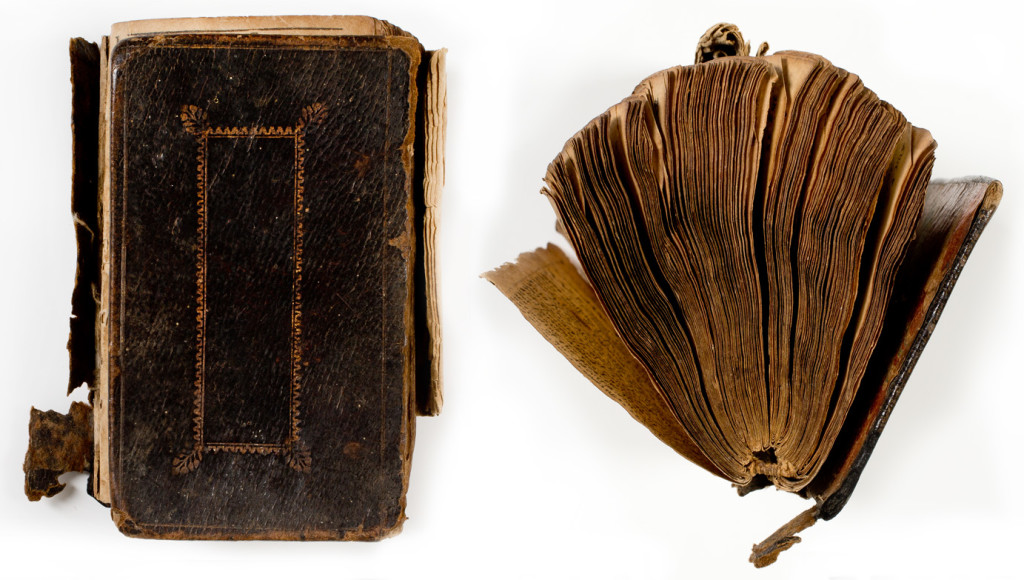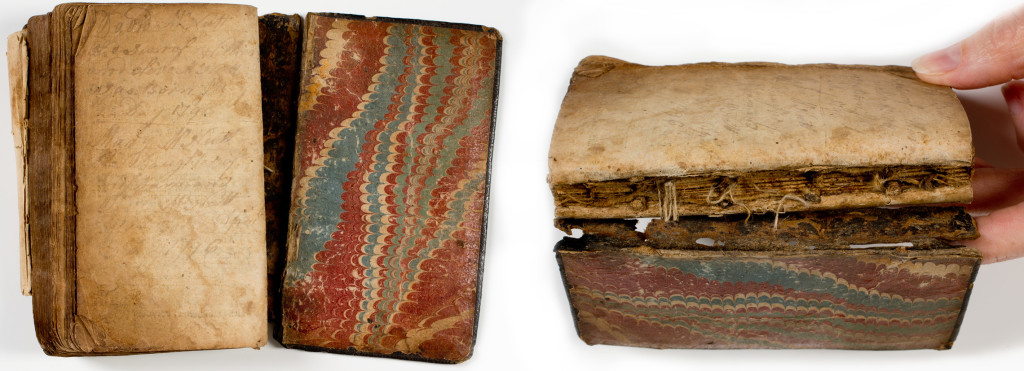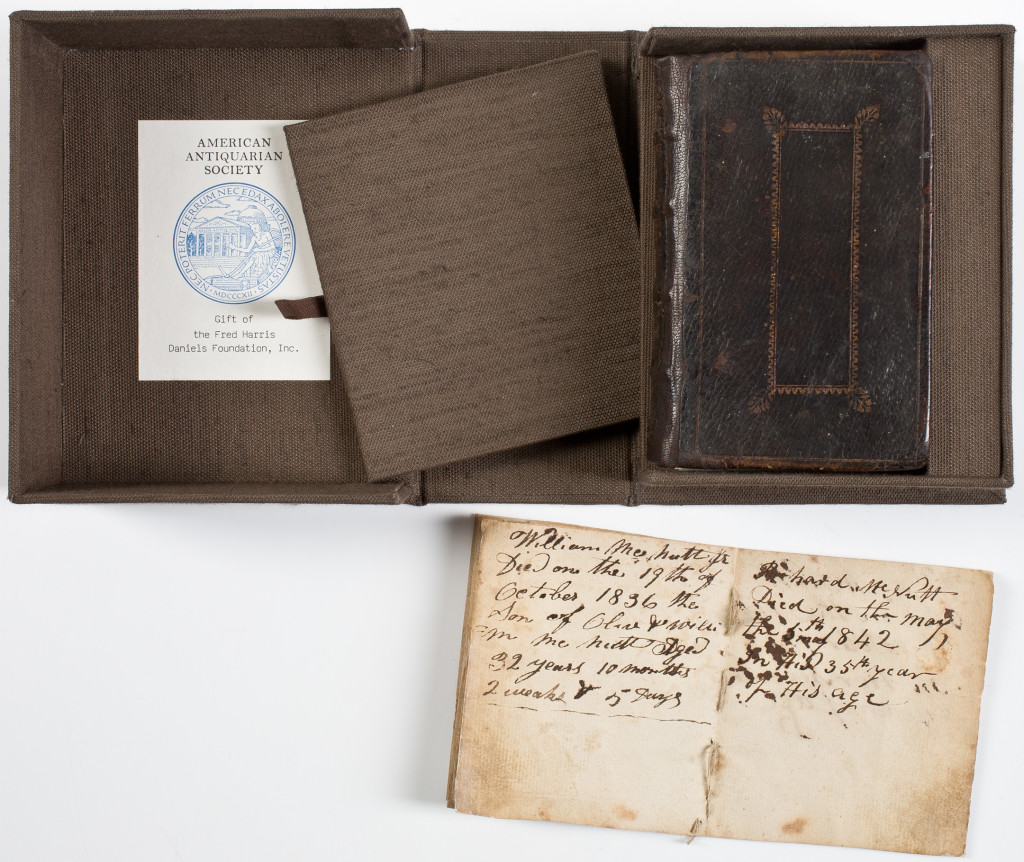The conservation of the exceedingly rare copy of the 1709 14th edition of the so-called Bay Psalm Book was recently completed, and it is now available for gentle study. This small, outwardly modest book was acquired in the fall of 2013, through funds generously donated by the Fred Harris Daniels Foundation in memory of Bill Pettit, after an observant dealer spotted it at an auction. Suffering from three hundred years of wear and tear, it arrived at the library with its front cover detached and its back cover weakly hanging onto the spine. A course of treatment was drawn up by Chief Conservator Babette Gehnrich, and, with the able help of Conservation Assistant Nancy Fresella-Lee, the book was restored to a readable condition. Happily, scholars can now turn its pages—albeit gingerly!

This acquisition has fittingly found a permanent home at AAS, where it joins its famous parent—the 1640 first edition of The Whole Book of Psalmes—as one of the library’s most prized possessions. It will be recalled that AAS holds one of only eleven extant copies of this book, the once commonly used, metered translation of the Psalms. It is renowned because it is the first book that was printed in British North America, by Stephen Day[e] in Cambridge (probably with his son Matthew) on a press owned by the recently widowed Elizabeth Glover, just two decades after the Puritans landed on the shores of the Massachusetts Bay. In 1698, for the 9th edition, “tunes” with musical notations were added following the Psalms—another landmark in the history of printing in the colonies. The 1709 14th edition that was printed and published in Boston by John Allen includes these musical notations, and, in addition to all its other accolades, this copy now represents the earliest example of music printed in North America in the AAS collections. (For a timeline describing all twenty-seven editions of the Bay Psalm Book, see the Almanac of March 2014.)

Conservation treatment
Though complete in its components, the worn condition of the book’s binding made it too unstable for safe handling. To address the foremost problem, reattaching the front cover and reversing the concave shape of the textblock, the entire book had to be disassembled. First, the original sewing was removed, the sections were separated, and the pages were lightly cleaned with eraser crumbs. A series of baths came next: first in cold water (which turned a satisfying yellow), followed by a second with the addition of calcium hydroxide to raise the pH level of the paper and loosen more dirt; and the third and final bath in a solution of water and magnesium bicarbonate to alkalize them. After drying on felts, the folios were sized with gelatin to restore the softened paper to an appropriate crispness and crackle. After washing, there was a notable difference in the paper’s color. It became lighter and brighter except around the edges, and thus is now closer to its original eighteenth-century state. While in this disassembled state, the entire volume was sent to the AAS photographer for digitization.

Following aqueous treatment and digitization, the folios were sewn back together, using the original holes. The original head and tail bands had been precariously dangling from the binding, so these had to be reconstructed. Since there were fortunately few tears within the book, only a minimal amount of paper repair was required. The (unidentified) eighteenth-century binder had used Dutch-pattern marbled (imported?) paper for the endpapers. To replace the missing flyleaves, salvaged period papers that closely match the originals were found amongst the lab’s stores. Finally, the original covers were reattached, and the spine, with its decorative tooling between the raised bands, was carefully glued over a new leather rebacking.
It is always a difficult decision to disturb the valuable historical evidence from an old binding. While repair could not be avoided in this case, all of the fragments that were removed from the book during its treatment—the head and tail bands, the sewing thread, and even the accumulated dust of three centuries that fell out of the page gutters—were carefully saved for posterity, and the treatment process was photographically documented.
A Treasure within a Treasure: A Surviving Book for the Ages

A further cause for celebration of this rediscovered rare book is yet another treasure that has been almost miraculously preserved between its damaged covers: an insert that reveals poignant proof of its early provenance. Four folded sheets that are shorter but wider than the pages of the book itself were sewn into the spine, between pages 190 and 191; the information handwritten on them undoubtedly reveals at least one pair of its former owners, William McNutt (1769–1821) and his wife, Olive (1774–1840). The booklet is a “Book of the Ages,” just like the one made by Benjamin Franklin’s youngest sister, which was the basis for historian Jill Lepore’s biography Book of Ages: The Life and Opinions of Jane Franklin. It was probably Olive who made the booklet, stitched it into her cherished copy of the Bay Psalm hymnal, and recorded her own name, her husband’s, those of their parents, and then her ten children in the order of their births (including two sets of twins). She died in 1840, so whoever added the latest recorded death date, 1842 (that of one of her sons, Richard Sweeney McNutt), was perhaps the next keeper of the book.
The “Book of the Ages” pamphlet was not sewn back into the book, because it protruded from the fore edge of the Bay Psalm textblock and was already frayed at the edges. This pamphlet is now stored and protected in a separate compartment in the custom-made box that holds the Bay Psalm Book.

